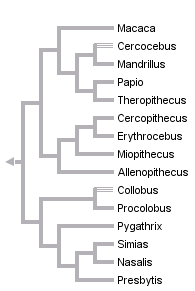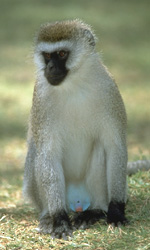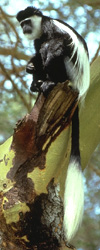Cercopithecidae
Old World monkeys



This tree diagram shows the relationships between several groups of organisms.
The root of the current tree connects the organisms featured in this tree to their containing group and the rest of the Tree of Life. The basal branching point in the tree represents the ancestor of the other groups in the tree. This ancestor diversified over time into several descendent subgroups, which are represented as internal nodes and terminal taxa to the right.

You can click on the root to travel down the Tree of Life all the way to the root of all Life, and you can click on the names of descendent subgroups to travel up the Tree of Life all the way to individual species.
For more information on ToL tree formatting, please see Interpreting the Tree or Classification. To learn more about phylogenetic trees, please visit our Phylogenetic Biology pages.
close boxReferences
Benefit, B. R. and M. L. McCrossin. 1993. The lacrimal fossa of Cercopithecoidea, with special reference to cladistic analysis of Old World monkey relationships. Folia Primatologica 60:133-145.
Disotell, T. R. 1994. Generic level relationships of the Papionini (Cercopithecoidea). American Journal of Physical Anthropology 94:47-57.
Disotell, T. R. 1996. The phylogeny of Old World monkeys. Evolutionary Anthropology 5:18-24.
Disotell, T. R., Honeycutt R. L., and M. Ruvolo. 1992. Mitochondrial DNA phylogeny of the Old World monkey tribe Papionini. Molecular Biology and Evolution 9:1-13.
Fleagle J. G. and W. S. McGraw. 1999. Skeletal and dental morphology supports diphyletic origin of baboons and mandrills. Proceedings of the National Academy of Sciences (USA) 96: 1157-1161. [Medline]
Harris, E. E. 2000. Molecular systematics of the Old World monkey tribe Papionini: analysis of the total available genetic sequences. Journal of Human Evolution 38:235-256.
Harris, E.E. and T. R. Disotell. 1998. Nuclear gene trees and the phylogenetic relationships of the mangabeys (Primates : Papionini). Molecular Biology and Evolution 15:892-900.
Harrison, T. and E. E. Harris. 1996. Plio-pleistocene cercopithecids from Kanam East, western Kenya. Journal of Human Evolution 30:539-561.
Jablonski, N. G. (ed.) 1993. Theropithecus: the Rise and Fall of a Primate Genus. Cambridge University Press, Cambridge.
Jablonski N. G. (ed.) 1998. The Natural History of the Doucs and Snub-Nosed Monkeys. 15th International Primatological Society Congress (1994: Bali Island, Indonesia). World Scientific, Singapore.
Page, S. L., C. H. Chiu, and M. Goodman. 1999. Molecular phylogeny of old world monkeys (Cercopithecidae) as inferred from gamma-globin DNA sequences. Molecular Phylogenetics and Evolution 13:348-359.
Purvis, A. 1995. A composite estimate of primate phylogeny. Philosophical Transactions of the Royal Society of London Series B 348:405-421.
Van der Kuyl, A. C, C. L. Kuiken, J. T. Dekker, and J. Goudsmit. 1995. Phylogeny of African monkeys based upon mitochondrial 12S rRNA sequences. Journal of Molecular Evolution 40:173-180.
Whitehead, P. F. and C. J. Jolly (eds). 2000. Old World Monkeys. Cambridge University Press, Cambridge. 528 pp.
Zhang, Y. P. and O. A. Ryder. 1998. Mitochondrial cytochrome b gene sequences of old world monkeys: With special reference on evolution of Asian colobines. Primates 39:39-49.
Information on the Internet
- Bioko Primate Protection Program (BiokoPR)
- The Douc Langur Project
- Cercopithecidae. The University of Michigan Museum of Zoology Animal Diversity Web.
- Spook Skelton's Baboon Gallery
Title Illustrations

| Scientific Name | Cercopithecus aethiops |
|---|---|
| Location | Tanzania |
| Comments | Vervet monkey |
| Copyright |
© 1999 Greg and Marybeth Dimijian

|
| Scientific Name | Colobus |
|---|---|
| Location | Lake Naivasha, Kenya |
| Comments | in yellow fever tree |
| Copyright |
© 1999 Greg and Marybeth Dimijian

|
| Scientific Name | Erythrocebus patas |
|---|---|
| Comments | Patas monkey, red guenon |
| Creator | H. Vannoy Davis |
| Specimen Condition | Live Specimen |
| Source Collection | CalPhotos |
| Copyright |
© 2001 California Academy of Sciences

|
About This Page
Page copyright © 1999
All Rights Reserved.
Citing this page:
Tree of Life Web Project. 1999. Cercopithecidae. Old World monkeys. Version 01 January 1999 (temporary). http://tolweb.org/Cercopithecidae/16297/1999.01.01 in The Tree of Life Web Project, http://tolweb.org/











 Go to quick links
Go to quick search
Go to navigation for this section of the ToL site
Go to detailed links for the ToL site
Go to quick links
Go to quick search
Go to navigation for this section of the ToL site
Go to detailed links for the ToL site